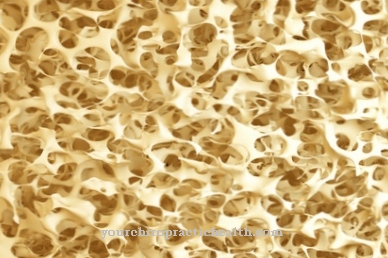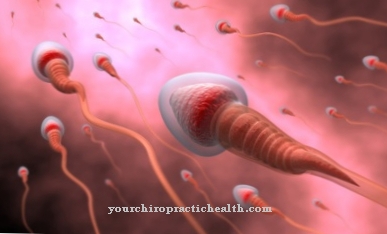The Anteversion occurs in the anatomical nomenclature as an alternative term for movement. Many functions on the arm and leg include this movement component.
What is the anteversion?

In the hip and shoulder joints, the term anteversion is used as an alternative to the term flexion. This means lifting the thigh or the upper arm from the zero position. While flexion is a term that is assigned by definition to a certain movement in descriptive anatomy, anteversion describes the process and direction.
'Ante', from the Latin for 'forwards', 'forwards', indicates the direction of movement and 'version', derived from the Latin 'versio' ('rotation'), describes the type of movement. In anteversion, a bone moves forward and rotates, it rotates.
Almost all movements of the human body are rotational movements. Usually there is a fixed joint partner with an imaginary axis of rotation around which the mobile rotates. If these movements are purely uniaxial, they can be clearly defined using a movement plane and a movement axis.
Accordingly, the anteversion takes place in the sagittal plane and around the transverse axis, which in the hip and shoulder joint can be thought of as a transverse line through the joint heads. The movement is clearly defined by adding the direction information.
Function & task
In addition to the purely uniaxial movement, the anteversion in the hip and shoulder joint is involved in almost all combined movements that are directed upwards. Everyday movements are mostly three-dimensional, one-dimensional patterns are rarely used.
In the shoulder joint, the anteversion is an important component in all activities that take place in a certain angular range in front of and above body level. Computer work, for example, contains this movement element, often combined with slight abduction and internal rotation.
Significantly more anteversion is required for overhead activities as they often occur in manual professions and in sports. Typical activities in which anteversion is required are painting overhead, for example painting or wallpapering. Bricklayers and stackers are also often in this area of movement, often even with weights.
Many sporting movements are initiated with a backward movement. This is the case with volleyball before smashing or blocking, in handball before throwing or defending. Anteversion is a major component in all of these activities.
In the hip joint, anteversion is an important component of many functional movements. The locomotion when walking and running is characterized by the lifting of the leg in the swing phase, usually accompanied by a slight abduction and a slight external rotation. While the thighs are only slightly lifted when walking, when running fast, angular degrees of over 90 degrees can easily arise. In all running sports, a well-functioning anteversion is an extremely important prerequisite for success. This also applies to disciplines that contain sprint elements, such as the run-up in high and long jump.
Another functional aspect in which the anteversion plays an important role is the preparation of jump and sprint activities. So that the subsequent sequence of movements runs optimally, it is better to start from a pre-stretched position. This can be seen well with sprinters who use the starting block for pre-stretching or with volleyball players before jumping to smack or block. In the crouched position, the extensors of the hip joint are elongated due to the anteversion position, the elastic elements are taut. The potential energy stored in this way can be used for an explosive start or jump.
The freedom of movement in the anteversion in the hip joint is the prerequisite for everyday actions. It ensures problem-free sitting as well as reaching a deep squat.
You can find your medication here
➔ Medicines against concentration disordersIllnesses & ailments
The execution of the anteversion can be impaired by injuries. These can be broken bones or pulled muscles and tears. The damage itself and the pain that occurs mean that movements are only carried out sparingly or not at all.
A typical injury in the hip joint is the femoral neck fracture, which mainly affects the elderly and has a massive impact on mobility. A characteristic trauma in the shoulder joint that leads to massive restrictions is shoulder dislocation as a result of excessive force. Raising the arm often causes problems for a long time, even after the straightening and further medical care.
A number of diseases are able to impair and limit the execution of movements. This includes all diseases that are associated with muscle loss. In muscular dystrophies, the muscle itself is affected. There is a progressive loss of strength with increasing disability and immobility. Amyotrophic lateral sclerosis has a similar effect, but the progressive course is usually much faster and life expectancy is more severely restricted.
Other diseases and injuries affect the nervous system. In this case, the muscles no longer receive any impulses. They fail completely or partially and atrophy. Typical injuries of this type are paraplegia due to spinal cord damage and peripheral nerve lesions. With all these impairments, the anteversion is particularly affected, as the movement in both the hip and shoulder joints is mainly carried out against gravity.
Degenerative diseases are another complex of diseases that lead to restricted mobility. Osteoarthritis is a common condition in the hip joint in which the joint cartilage is increasingly broken down. The result is pain and restricted movement and activity. First of all, the movements that are directed against gravity, such as anteversion, are also affected here. The shoulder joint is often affected by permanent irritation of the structures under the shoulder roof, the impingement syndrome. As a result of the painful irritation, the arm is spared and upward movements are avoided as far as possible.



























